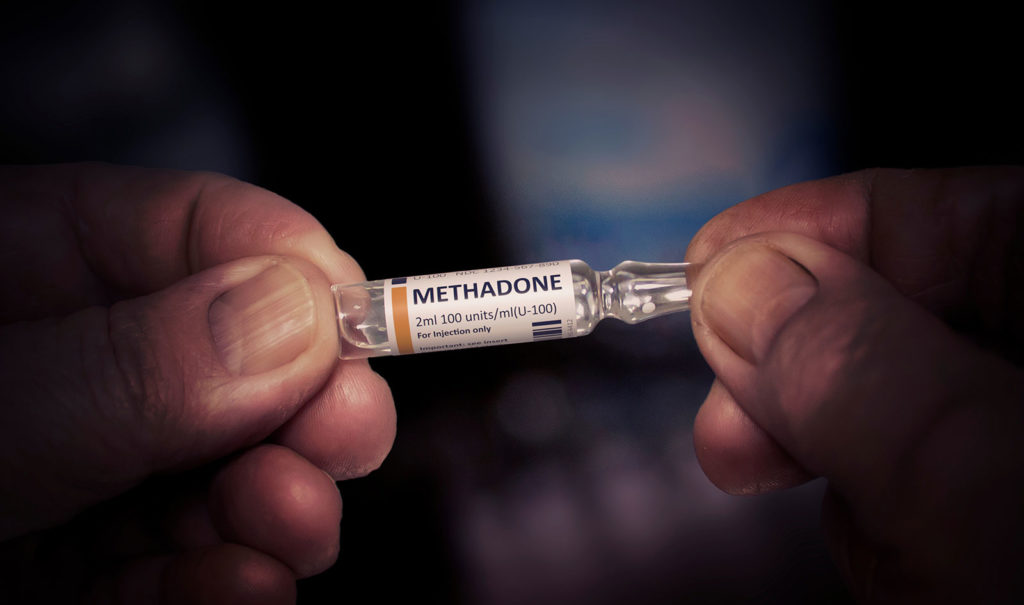Methadone is a synthetic (man-made) long-acting opioid used to treat chronic pain and opioid use disorder.
Developed in Germany in the late 1930s by Max Bockmühl and Gustav Ehrhart, Methadone was primarily used to treat pain. It was introduced in the United States in the late 1940s as an analgesic and later, in the 1960s, approved for the treatment of opioid addiction.
Methadone is often prescribed for long-term use, dispensed in regulated clinics to prevent misuse. But how long can you be on methadone, exactly? Here’s everything you need to know.
Table of Contents
How Does Methadone Work?
Methadone changes the way the brain and nervous system respond to pain and opioids.

It lessens the symptoms of opiate withdrawal and blocks the euphoric effects of opioid drugs such as heroin, fentanyl, morphine, and codeine.
It has a long half-life and tends to keep patients satiated for 24 to 30 hours, depending on the dosage.
Does Methadone Treat Opioid Addiction?
By itself, methadone doesn’t treat opioid addiction. Instead, it’s part of a comprehensive treatment program that includes therapy, counseling, and lifestyle changes to support recovery.
During therapy, methadone is used as a substitute for heroin. Those who take it as prescribed still depend on opioids on a physical level, and stopping its use may bring back the cravings and withdrawal symptoms associated with opioid addiction.
Methadone blocks the euphoric effects of opioids, allowing people struggling with opioid use disorders (OUDs) to function without intense cravings and focus on therapy. And although it provides feelings of relaxation, it doesn’t give you the same high as heroin, minimizing the risk of a relapse.
Does Methadone Treat Opioid Addiction?
Long-term use of methadone can result in dependence, which can lead to substance abuse and addiction.
Methadone doesn’t produce the same high as opioids like heroin and morphine, but it does provide a sedative effect when taken in high doses or conjunction with alcohol and other drugs.
If a person stops taking methadone abruptly, they may experience withdrawal symptoms similar to other opioids. Side effects of methadone include:
- Diarrhea
- Constipation
- Anxiety and restlessness
- Abdominal cramps
- Gastrointestinal discomfort
- Muscle aches and pains
- Nausea and vomiting
- Psychological symptoms like mood swings, depression, and irritability
- Intense cravings
People become addicted to methadone as an unintended result of replacement therapy or by taking the drug recreationally.
When the body becomes used to methadone, it needs more of it to get the same effect. Increased tolerance leads to dependency, causing the person to take more of the drug to feel ‘normal.’ Once they become dependent on methadone, they fall into addiction.
The other way to become addicted to methadone is by taking it recreationally. Methadone has sedative effects, which some people prefer over intense highs. And although methadone isn’t easy to get, the fact that it’s legal makes it more tempting to acquire than heroin and other illegal opioids.
Signs of Methadone Addiction
Often, people don’t realize they’ve become dependent on methadone until it’s too late.
Since it’s prescribed as a part of a treatment plan, people fall into a false sense of security and believe they’re cured of the addiction. However, methadone itself is an opioid, and withdrawal from it can be just as difficult—sometimes even longer-lasting—than from heroin or other opioids.
This is why recognizing the early signs of methadone addiction is so important. Patients healing from opioid addiction shouldn’t feel like they’re switching from one bad drug to another. Here are some of the early signs of methadone dependency/addiction:
- Needing higher doses to achieve the same effects
- Frequently thinking about the next methadone dose (drug cravings) or feeling anxious about running out
- Staying on methadone longer than medically necessary without reassessment
- Experiencing excessive tiredness or nodding off frequently
- Saving extra doses instead of taking them as prescribed
- Unexplained weight gain or loss
- Experiencing nausea, headaches, dizziness, or flu-like symptoms when a dose is missed or delayed
What Does Methadone Addiction Treatment Look Like?
Methadone maintenance treatment, often provided at a treatment center, is similar to treatment for other opioid addictions.
This includes medical detox using opiate antagonists (naloxone/naltrexone), non-opioid medication (clonidine), and over-the-counter medications (loperamide for diarrhea, ibuprofen for muscle pain, promethazine for nausea, etc.) to reduce symptoms of withdrawal.
Then, patients will partake in inpatient therapy and counseling to address the psychological aspects of addiction.
Aftercare programs like outpatient treatment, support groups, and sober living environments also play a key role in long-term recovery.
How Long Can You Be on Methadone?
Methadone is a long-term treatment for opioid addiction. Some healthcare professionals prescribe methadone treatment for months, years, or even indefinitely. As long as methadone proves to be beneficial for their health, it can be taken regularly.

What Are the Risks of Long-Term Methadone Use?
Methadone must be taken under the prescription of a healthcare professional. If taken incorrectly, patients may suffer long-term health complications such as:
Respiratory issues
Methadone is a central nervous system (CNS) depressant, meaning it slows breathing.
In high doses or when combined with other depressants, such as benzodiazepines or alcohol, it can cause dangerous respiratory depression (hypoventilation), a breathing disorder characterized by slow and shallow breathing.
Respiratory depression can result in respiratory failure, pulmonary hypertension, pneumonia, high or low blood pressure, obstructive sleep apnea, and, in worse cases, coma and cardiac arrest.
Heart Problems
Methadone can prolong the QT interval in the heart’s electrical cycle, increasing the risk of an irregular heartbeat (arrhythmia) and a potentially fatal condition called torsades de pointes—a risk most common in people with existing heart conditions.
Due to this, clinicians often avoid prescribing methadone to people with underlying heart conditions or if they’re taking certain medications like antidepressants, antifungals, diuretics, and corticosteroids.
Severe Withdrawal Symptoms
Patients who discontinue the use of methadone may experience methadone withdrawal symptoms even if they take methadone exactly as prescribed and don’t crave it psychologically.
Since it’s often taken long-term, the brain rewires itself to accommodate the neurological and physical effects of methadone. If the substance is suddenly taken away, it will trigger opioid withdrawal symptoms like nausea, sweating, and muscle pain, to name a few.
Neonatal Abstinence Syndrome
Some research suggests that mothers who take methadone during pregnancy increase the risk of Neonatal Abstinence Syndrome (NAS), a condition that causes a baby to experience withdrawal-like symptoms from birth.
However, some studies have also found that methadone improves birth outcomes among women with opioid use disorders because withdrawal during pregnancy is linked to premature birth and miscarriage.
Methadone greatly reduces and sometimes even prevents withdrawal symptoms, which can help women manage their opioid use disorder better, per SAMHSA (Substance Abuse and Mental Health Services Administration).
Pregnant and breastfeeding women must therefore closely work with their physicians to minimize the risks of taking methadone during pregnancy.
Thankfully, Neonatal Abstinence Syndrome is treatable and infants born with it can lead happy and healthy lives if treated at an early age.
Can a Methadone Overdose Cause Death?
Methadone overdose can result in death in severe cases, according to the National Institute on Drug Abuse.
People who take large doses of methadone often die due to respiratory depression, a condition where breathing slows down dangerously or stops altogether.
Methadone overdose can also cause seizures, though it’s less common than respiratory depression. The person’s breathing may slow to the point where the brain is deprived of oxygen (hypoxia), which can trigger seizures and lead to brain damage.
That said, people who overdose on methadone are typically prescribed the drug for pain treatment, not OUD treatment. Those who take methadone for addiction don’t feel satiated with the sedative effect of methadone, especially since they’ve already experienced the high of stronger opioid drugs.
Moreover, methadone overdose deaths are often linked to individuals who obtain the drug from unauthorized sources rather than through a prescription. Usually, they’re taken not as a way to get high but as a way to control their cravings and withdrawal symptoms. But since they’re not given a prescription, they may accidentally overdose themselves.

When Do Doctors Consider Methadone No Longer Necessary?
Although some people take methadone indefinitely, others eventually reduce their dosage and eventually stop using it under medical supervision. A doctor may consider a stop to long-term methadone treatment when the following conditions are in place:
- Stability in recovery: The patient has maintained long-term sobriety (5 years+), has a stable lifestyle, and is no longer at high risk of relapse.
- No more cravings or withdrawal symptoms: The patient no longer experiences strong opioid cravings or withdrawal symptoms when doses are reduced.
- Healthy coping mechanisms: The patient has developed healthy coping mechanisms with the help of healthcare professionals.
- Support system in place: The patient has access to therapy, support groups, or other resources to help maintain recovery without methadone.
When doctors deem a patient fit to discontinue the use of methadone, they’ll gradually lower the dosage (tapering) to minimize withdrawal symptoms and reduce the risk of relapse.
Final Thoughts
Methadone is used as part of an ongoing treatment for opioid addiction.
Depending on the severity of the addiction, people may take methadone for months, years, or even indefinitely.
Taking methadone outside of the doctor’s instructions can result in a myriad of health issues and sometimes worsen the very symptoms it was meant to manage.
If you or a loved one is struggling with methadone addiction, we’re here to help. Contact a treatment provider today to get the guidance and support you need.



